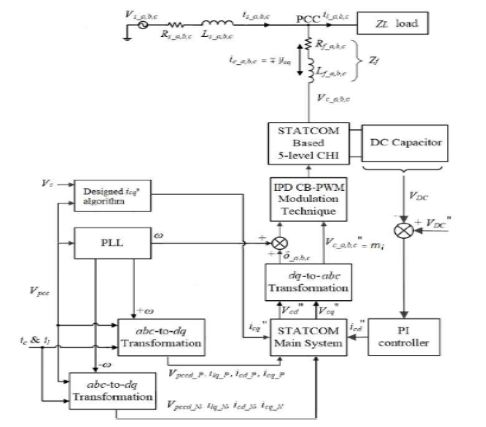High Reactive Power Compensation Accuracy for Cascaded H-Bridge Inverter based Decoupling Feed-Forward Current Vector Controller
Objective
The main objective of this project is to define a control scheme and its transfer function in order to achieve low switching frequency and high-bandwidth power control of MCHI.
Abstract
The Static Synchronous Compensator (STATCOM) has gained popularity among many utilities for solving power quality problems in distribution substations. There are many types of topologies for STATCOM found in the literature, of which the Multilevel Cascaded H-bridge Inverter (MCHI) is the most adaptable and energy efficient power inverter topology. The aim of this paper is to define a control scheme and its transfer function in order to achieve low switching frequency and high-bandwidth power control of MCHI.
The controller of the proposed STATCOM system is implemented to provide vector control for reactive power or Voltage-Ampere Reactive (VAR) compensation at the Point of Common Coupling (PCC) under balanced loading conditions.To accomplish this, mathematical equations for a STATCOM system is derived in dq-coordinates based on Park’s transformation. Then, the designed equations are used to calculate appropriate values of the controller’s gain parameters for realizing the cascade Pulse Width Modulation (PWM) STATCOM with various voltage and current ratings. Lastly, the performance of the proposed control scheme is verified through simulation and numerical analysis using MATLAB-Simulink.
Keywords: STATCOM, VAR compensation, Multilevel inverter, PWM, THD.
NOTE: Without the concern of our team, please don't submit to the college. This Abstract varies based on student requirements.
Block Diagram

Specifications
Software Configuration:
Operating System : Windows 7/8/10
Application Software : Matlab/Simulink
Hardware Configuration:
RAM : 8 GB
Processor : I3 / I5(Mostly prefer)
Learning Outcomes
- Introduction to Matlab/Simulink
- What is EISPACK & LINPACK
- How to start with MATLAB
- About Matlab language
- About tools & libraries
- Application of Matlab/Simulink
- About Matlab desktop
- Features of Matlab/Simulink
- Basics on Matlab/Simulink
- Introduction to power electronics converters
- Introduction to phase locked loop (PLL)
- Introduction to PWM techniques
- Design of PLL
- Introduction to FACTS devices
- Design of STATCOM
- Introduction to Multilevel inverters
- Design of cascaded H-bridge multi-level inverter.
- Design of simpower systems tool boxes
- Design of simulink tool boxes
- We can learn about the generation of gate pulses to the converter
- Design of IPD CB –PWM.
- Introduction to open loop and closed loop control system
- Introduction to controllers
- Design of PI controller
- We can learn about the Clarke’s transformation
- We can learn about the park’s transformation
- Project Development Skills:
- Problem analyzing skills
- Problem solving skills
- Creativity and imaginary skills
- Programming skills
- Deployment
- Testing skills
- Debugging skills
- Project presentation skills
- Thesis writing skills


 Paper Publishing
Paper Publishing
